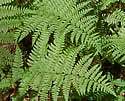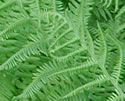Athyrium Filix-femina (Lady Fern)
| Also known as: | |
|---|---|
| Genus: | Athyrium |
| Family: | Dryopteridaceae (Wood Fern) |
| Life cycle: | perennial |
| Origin: | native |
| Habitat: | part shade, shade, sun; moist woods, swamps, bogs, stream banks |
| Fruiting season: | summer |
| Plant height: | 16 to 40 inches |
| Wetland Indicator Status: | GP: FAC MW: FAC NCNE: FAC |
| MN county distribution (click map to enlarge): |  |
| National distribution (click map to enlarge): |  |
Pick an image for a larger view. See the glossary for icon descriptions.
Detailed Information
Fiddlehead:
![[photo of fiddlehead]](/udata/r9ndp23q/ferns/lady-fern_0518_190651-t.jpg) Fiddleheads emerge in early spring.The slender stem is covered in dark brown scales.
Fiddleheads emerge in early spring.The slender stem is covered in dark brown scales.
Leaves and stems: 

![[photo of frond]](/udata/r9ndp23q/ferns/lady-fern_0504_153711-t.jpg) Leaf is twice compound, lance-elliptic in outline, broadest at or slightly below the middle, tapering to a point at the tip, 16 to 40 inches long and 4 to 14 inches wide, with 20 to 30 pairs of branches (pinnae). Branches are linear-oblong in outline, gradually tapering to a point, with a minimum of 8 pairs of leaflets (pinnules) in an opposite or alternate formation.
Leaf is twice compound, lance-elliptic in outline, broadest at or slightly below the middle, tapering to a point at the tip, 16 to 40 inches long and 4 to 14 inches wide, with 20 to 30 pairs of branches (pinnae). Branches are linear-oblong in outline, gradually tapering to a point, with a minimum of 8 pairs of leaflets (pinnules) in an opposite or alternate formation.
![[photo of leaflets]](/udata/r9ndp23q/ferns/lady-fern_0426_150211-t.jpg) Leaflets have rounded or pointed lobes and tips, rounded or pointed (but not bristly) teeth, and forked veins that do not typically extend quite all the way to the leaflet edge. The opposing lobes at the base of a leaflet are often unequal in size.
Leaflets have rounded or pointed lobes and tips, rounded or pointed (but not bristly) teeth, and forked veins that do not typically extend quite all the way to the leaflet edge. The opposing lobes at the base of a leaflet are often unequal in size.
![[photo of lower stem]](/udata/r9ndp23q/ferns/lady-fern_0504_153751-t.jpg) Stems are slightly grooved, green to straw colored, darker at the base, with light to dark brown scales scattered on the lower stem. One distinctive form has red stems. Leaves form a circular cluster or asymmetrical clump.
Stems are slightly grooved, green to straw colored, darker at the base, with light to dark brown scales scattered on the lower stem. One distinctive form has red stems. Leaves form a circular cluster or asymmetrical clump.
Spores: 
![[photo of immature sori]](/udata/r9ndp23q/ferns/lady-fern_0529_145836-t.jpg) The sori (cluster of spores) develops on the back of the leaf blade in summer and is typically curved to hook-shaped, though is sometimes straight. A translucent tissue (indusium) partly covers the spores and is visible long before the spores develop.
The sori (cluster of spores) develops on the back of the leaf blade in summer and is typically curved to hook-shaped, though is sometimes straight. A translucent tissue (indusium) partly covers the spores and is visible long before the spores develop.
![[photo of mature sori]](/udata/r9ndp23q/pd3/athyrium-filix-femina-sori-s2-t.jpg) Mature sori are brown. Spores are only present on some leaves; fertile and infertile fronds are indistinguishable from the front though, when sori mature, the leaflet edge can roll around the sori some.
Mature sori are brown. Spores are only present on some leaves; fertile and infertile fronds are indistinguishable from the front though, when sori mature, the leaflet edge can roll around the sori some.
Notes:
There is a lot of variability in the form of Lady Fern but the key to identification is that the sori are mostly curved (like a lady's eyebrow) and there are scales on the stem (like a woman's hairy legs). The general shape and growth pattern of Lady Fern looks similar to some Dryopteris species (D. intermedia and D. carthusiana in particular) but can be differentiated because it does not have bristly teeth (may be seen with a hand lens) and on the bottom-most branch of a frond, Lady Fern is 2 times compound while D. intermedia and D. carthusiana are 3-times compound. A word of caution - I have seen this species often mis-identified. While at the Home Depot, I saw plants being sold that were labeled Lady Fern...but in reality it was a Dryopteris species. Having said that, Lady Fern does make a good addition to a garden. “Flora of North America”, our definitive reference, lists 4 varieties of Lady Fern in North America. Some references include var. cyclosorum in Minnesota but there are no herbarium records to support that; var. angustum is the only known variety in Minnesota at this time. - Cindy Hoffmann
Native Plant Nurseries, Restoration and Landscaping Services ↓
More photos
Photos by K. Chayka taken in Ramsey, Pine and St. Louis counties. Photos by Peter M. Dziuk taken in a private garden in Anoka County.
Comments
Have you seen this plant in Minnesota, or have any other comments about it?
on: 2014-05-11 05:44:20
Hi, I am new to learning about ferns. I went to Perrot state park in Wisconsin yesterday and saw a number of ferns. I think that two of them I saw might be an ostrich and a lady fern but am not sure about that. Are there groups one can join that do field trips to learn about ferns? Thanks. Kevin
on: 2014-05-11 20:59:00
Kevin, I am not aware of any groups that focus on ferns, or offer any special instruction on them. The MN Native Plant Society has a few field trips every year to various habitats where you might learn something about them, but they won't highlight ferns in particular. Not much help, I know.
on: 2015-05-10 22:24:27
I noticed ferns growing along highway 169 do you know of what variety they are?
on: 2015-05-11 05:38:25
Michael, we are not familiar with the stretch of highway you mentioned, but there are many ferns in MN and come in all sizes and shapes, some of which grow in shaded woodlands and woodlines, some of which will grow in more open, sunny spaces. A picture is often worth 1000 words. If, after reading the other fern profile pages, you are still unable to identify it, you may post a picture on our Facebook page and we'll see if we can figure it out.
on: 2015-06-01 13:05:35
I believe I may have a lady fern, bought at the infamous Home Depot with no ID other than "fern" I was told it was strictly indoor. In my quest to identify I believed it may have been a small variety of the Dryopteris family but could not find a suitable match. It has no spores at this time, other than that are there any other identifying factors for the lady fern that I may solve this once and for all? Sorry this is not about a wild growing plant, I am simply desperate to identify this poor thing.
on: 2017-05-14 12:30:40
I have several ferns of the same type that volunteer themselves in my garden. I think they may be Lady Ferns. We are trying to turn our garden into a native plant area so I'm wondering if that's what they are. If so, I will leave them alone. Is there a way to send pictures in order to get help in identification? Thank you!
on: 2017-05-14 13:45:33
Brenda, the Notes section describes how to ID lady fern, from the spore pattern on the backs of leaves and the scales on the lower part of the stems. If your specimens don't match the description then you have something else, but in any case you need to look at the spore pattern and other characteristics for a positive ID. Note, however, that there are no non-native ferns in the wild in Minnesota, and we aren't aware of any garden escapees, so whatever you have is a native. If need be, post your photos on our Facebook page.
on: 2018-06-06 19:37:58
I have something that is eating the leaves on my little oak fern, lady fern, cinnamon fern and sensitivity fern. Do you have any idea what this may be? It looks like some insect or something, not rabbits. I have had these fern for many years and have had nothing bother them before.
on: 2020-05-15 13:43:20
Red stems, dainty fronds?
on: 2021-04-14 15:50:06
We think this is the fern growing on our greenhouse floor. It is just now emerging.
on: 2022-07-27 18:32:56
Hello! I was walking in the a forest preserve area called Savage Fen near my house and came upon an opening with a huge bed full of these beauties!! I didn?t have my phone but I made sure to look them up when I got home. They?re just so neat how they spread out and blanket the forest floor.







 Lady Fern plant
Lady Fern plant garden-grown Lady Fern
garden-grown Lady Fern